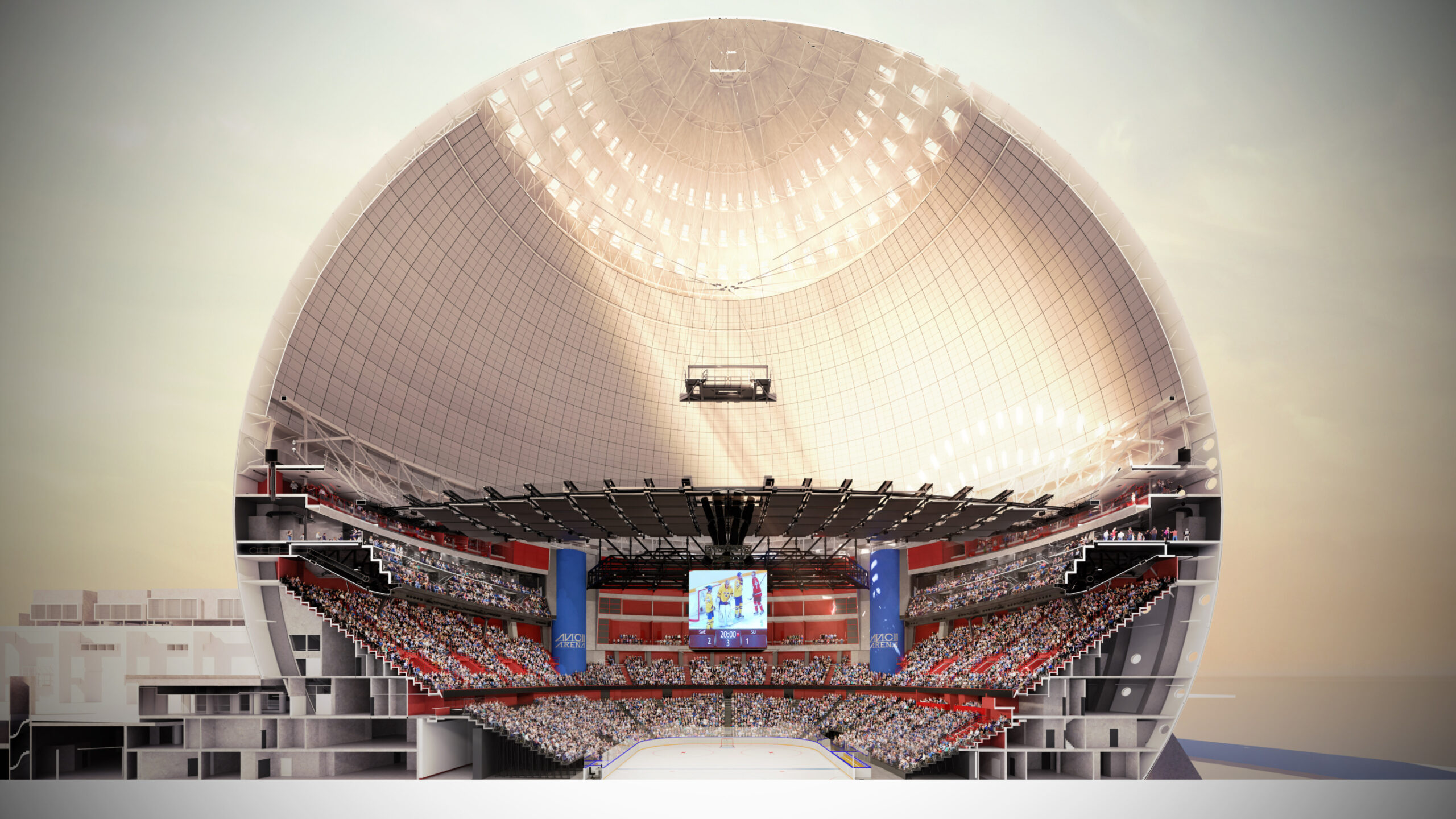The world’s largest spherical building has been renovated and brought up to speed by HOK, C.F. Møller Architects, and schlaich bergermann partner, adding more capacity and a new acoustic system to the arena.
Section of the arena draws similarities to Etienne-Louis Boullée’s Newton Cenotaph concept. (Section drrawing by HOK)
Photos
CF Møller Architects
HOK, C.F. Møller Architects, and schlaich bergermann partner (sbp) have completed the extensive renovation and modernisation of Stockholm’s Avicii Arena. Originally opened in 1989 as the Stockholm Globe Arena, the structure remains the world’s largest spherical building and one of the city’s most recognisable landmarks. The project, carried out for NCC and client SGAF (fully owned by the city of Stockholm), ensures the arena continues to serve as a world-class venue for sports, concerts, and cultural events while preserving its distinctive architectural identity.
A sophisticated steel ring structure now supports a retractable acoustic panel system and new rigging infrastructure. Balancing technological innovation with heritage conservation, the work done creates a more adaptable space without compromising the arena’s celebrated spherical form. Enhancements include new seating tiers, reconfigured lounges, and gondola seating, all aimed at improving visitor experience.
Addressing the increasing demands of contemporary large-scale events, the new retractable acoustic system is suspended within a curved inner ring structure, while the outer perimeter compression ring ensures structural stability. A lightweight cable-net supports both the panels and the rigging elements, incorporating a walkable mesh for safety and accessibility. The result is an arena that can swiftly transform between an intimate concert setting and a high-capacity stadium, providing unparalleled acoustic and spatial flexibility.
New views of the arena’s expansive (new and pre-existing) architecture have been added too. “Gondola” seats replace what was previously ‘Tier C’ within the arena with four rows – equating to 400 seats on either side – of cantilevered seating. These feed off from new hospitality facilities and integrate ventilation infrastructure for the tiered seating below.
Reopening on February 1 with a sold-out performance by Swedish electronic duo Kite, the venue marked a new era where state-of-the-art acoustics and flexible configurations allow it to host an even broader range of performances and sporting events.
Seating for events such as ice hockey has been catered for as well. The arena’s ‘Tier A’ seating has been replaced with new retractable and fixed seats, allowing spectators to get closer to action on the ice rink. To the rear of this tier, “bass straps” have been added to enhance acoustics.
For the design team, preserving the arena’s legacy while preparing it for the future was paramount. “This project celebrates the past while embracing the future,” said Kirsty Mitchell, senior project manager at HOK. “Our approach enhances the arena’s original architecture while introducing forward-thinking solutions that ensure its longevity.”
Mårten Leringe, partner at C.F. Møller Architects meanwhile, emphasised the balance of form and function: “By blending technical innovation with intelligent design, we have reinforced the Avicii Arena as both a cultural landmark and a high-performance venue.”
Structural specialists sbp focused on reinforcing the original framework while integrating the new features. “Updating a structure as unique as Avicii Arena requires a careful balance of preservation and innovation,” added Knut Stockhusen, board member at sbp. “This project highlights how structural engineering can support architectural heritage while enabling contemporary performance demands.”
1. Superstructure and Cable net – a structural ring truss suspends the hyperbolic paraboloid cable net which in turn supports component (2). Its configuration allows for the loads to be transferred as directly as possible into the building’s original structure, without affecting the dome above.
2. Retractable acoustic panels and rigging system – movable panels integrating both absorbing and reflecting acoustic materials enable careful calibrations of the ceiling’s configuration, in accord with the productions’ acoustic requirements. A walkable mesh warrants a large and safe working platform to host future events.
3. End Stage Rigging Grid – replaces the existing grid with safe working platforms and a structural arrangement able to take higher load demands from contemporary productions.
4. Sky lounges – decommissioned former suites are converted into open space lounges directly connected with Gondola spaces below, and allow views back into the city via the building’s original windows
5. Gondolas – replacing former Tier “C” with more than 400 seats each side, brought as close as possible to the event floor, and creating new hospitality spaces inside the dome.
6. Tier “B” – new seats replacing all of the former ones, with a new, efficient redistribution within seated areas
7. Tier “A” – entirely new component replacing the former one, with a mix of predominantly retractable and fixed seats, new tier configuration to better adapt to Ice Hockey mode, bringing spectators closer to the action.
Credits
Client
Stockholm Globe Arena Fastigheter AB (SGA Fastigheter), fully owned by city of Stockholm
Architect
HOK, CF Møller Architects, sbp
Main contractor
NCC Building Sweden
Source: Architecture Today






